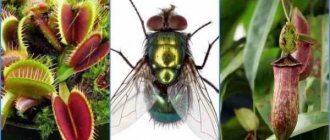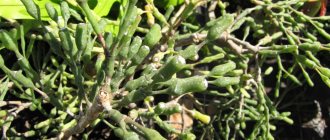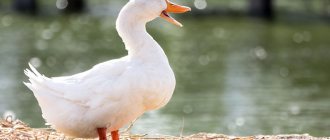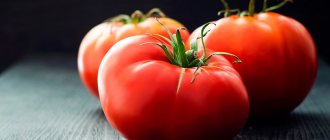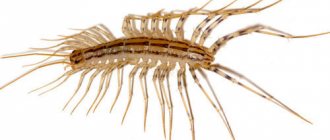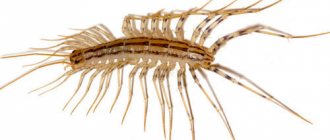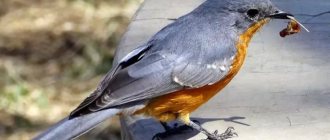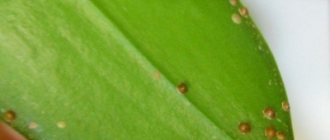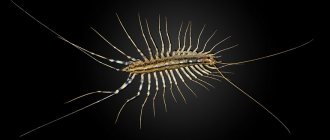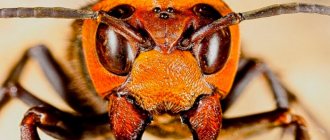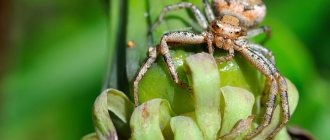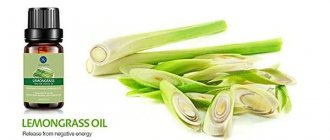The Venus flytrap, also known as Dionaea, is grown by indoor plant lovers around the globe. It is so popular mainly due to its original exotic “appearance”, the brightness of the shade of the traps, as well as its unusual behavior for most indoor plants. This is a carnivorous plant that loves to eat insects. The process of “hunting” performed by this flower is an interesting spectacle. However, it is difficult to care for at home. And in this article we will try to discuss the process in as much detail as possible.
Briefly about planting Dionaea and subsequent care
Blooms for a few weeks in late spring/early summer.
Necessary lighting - bright sunlight should be provided for four or five hours every day, diffused light the rest of the time. Can be grown on western and eastern windowsills. If the plant is kept in a terrarium or florarium, the grower will have to install artificial lighting.
Important! The temperature in summer should be 20-30 degrees Celsius. In winter, 7 degrees Celsius is acceptable.
Moistening the soil - keep dionaea on a tray with rain/distilled water. The pot must have drainage holes so that the plant itself receives moisture.
The air should be very humid. This is easiest to achieve in a terrarium or florarium.
No fertilizer is needed at all: Dionaea gets enough nutrients by eating insects. While there are traps, she needs to feed a couple of small flies alive. And each time, use a trap that was not used during the given flowering period.
For the dormant period in the fall, it is necessary to reduce watering and not leave water in the pan. In this case, keep the flower at a temperature of seven to ten degrees Celsius until spring, in a dark place, without feeding. You just need to water the plant occasionally. The rest period ends with the onset of March. At this time, it’s time to return the plant to the windowsill, cut off last year’s traps, and begin to gradually return to the summer regime of watering and feeding with insects.
Important! Replant approximately once every couple of years, in the spring, when the plant is actively growing.
It can be propagated by dividing the bush, leaf cuttings, and if you can pollinate it yourself, then by seeds.
The parasites are aphids and spider mites.
The flower can be sick from sooty fungus.
Now let's describe these nuances in more detail.
Temperature
The flycatcher is native to the tropics, so it is thermophilic. During the growing season, the plant will feel comfortable at a temperature of 22-300C, but increasing the indicators to 35-380C will not significantly affect its well-being. This temperature regime should not be constant. In winter it must be reduced to 8 degrees.
Dionea cannot stand the stuffiness. The room where the plant is located must be regularly ventilated, but drafts are harmful to the predator flower.
Description of the plant
Dionaea is a perennial insectivorous grass of the Sundew family. There is only one species in her genus, and that is herself. An adult plant usually does not grow higher than 60 cm; it often has a “height” of 10-15 cm. A long peduncle with white flowers that make up corymbose inflorescences sits on a bulbous stem. It is natural for this plant to grow on soil that contains almost no nitrogen, and therefore it obtains this element from insects and mollusks such as slugs.
Dionaea has four to seven leaves arranged in a rosette on a short underground stem. Traps grow after the plant has flowered. They grow up to eight to fifteen centimeters in length, they themselves are green, but in bright light it is clear that the internal cavities are red. Traps appear on the short petioles that make up the rosettes. During the rest of spring, they lengthen and stand upright. The traps are made of a pair of slamming doors. Those have sparse bristles along the edges. The trap has certain glands for producing bait nectar. Along the edges of the trap there are not only bristles, but also a trio of triggers - something like an alarm: the insect is irritated by the trigger, the trap slams shut, the flower begins to secrete a substance for digestion.
Important! The plant digests one insect for five to ten days, and then opens the trap again. It usually dies after digesting a couple of insects. But occasionally this number can increase to seven.
Features of a predatory flower
The botanical name of the plant is Dionaea muscipula, and the word muscipula translates as “mousetrap”. Probably, the discoverer, when describing it, decided that the trap leaves slammed shut like a mousetrap. The genus to which the green predator belongs is called Dionea, the family is Sundews. The appearance of the Russian species term is associated with the Roman goddess of love and plants - Venus. The English name Venus flytrap in translation sounds the same as the Russian name.
A botanical description of the Venus flytrap species gives an idea of all the features of this unusual flower:
- Herbaceous perennial plant 10–15 cm high.
- The bulbous stem is located in the ground.
- The leaves form a rosette.
- In spring, flower stalks grow 30 cm or more long.
- The flowers are about 3 cm in diameter, graceful, white, and have 5 white petals.
- After flowering, special trap leaves with short petioles are formed.
- Each trap is formed by two concave valves with sparse seta teeth and sensitive hairs along the edges (which is clearly visible in the photo).
- The trap leaves are green on the outside and turn pink or red on the inside (depending on the variety and cultivar).
The miniature parameters of the carnivorous plant and its spectacular appearance ensured the interest of exotic fans in it. The Venus flytrap settles comfortably on home windowsills.
Sensitive hairs of the plant trigger the leaf slamming mechanism only when exposed to live prey. The leaf closes and digestive juice is released. After a successful catch, the flytrap needs 5–10 days to digest the food, after which the plant is again ready to “hunt.”
Interesting facts about Dionea:
- The creator of the theory of evolution, Charles Darwin, considered this species “the most beautiful plant in the world.”
- The trapping leaves of the predatory flower produce sweet nectar to attract prey.
- The flower stalks are much longer than the leaves, so that the traps do not lure pollinating insects of the flower into their nets.
- After digesting 2-5 victims, the trap dies.
The natural species lives in swampy areas in the eastern United States in the states of Florida, North and South Carolina. The soil in such places contains too little nitrogen. It is vitally important for the predatory Venus flytrap plant to receive the necessary nutrients, which peat is poor in. An ingenious mechanism for capturing and digesting prey helps the species survive in nature.
How does slamming happen?
The main attraction is the red color of the traps, achieved by a pigment called anthocyanin. The cells also secrete a sticky protein. Once trapped, the prey immediately begins to flounder and slide on the sticky surface, simultaneously trying to consume more of this protein. In this case, the victim invariably touches the trigger hairs, and they signal that it is time to close the trap.
There are four phases of the Dionaea trap closing:
- initial slamming;
- compression phase;
- sealing phase;
- reopening phase.
“Trigger hairs” are essentially a signal for Dionaea, which senses from their vibrations that food has fallen into a natural trap.
Important! If two hairs vibrate at once or one of them vibrates twice with an interval of no more than half a minute, it takes one tenth of a second for the trap to close.
Closing a Dionaea trap is one of the fastest movements of representatives of the plant kingdom. The duration of the slamming process is determined by many factors. For example:
- ambient temperature;
- amount of light received;
- the health of the plant itself.
However, a healthy Dionaea in good conditions collapses extremely quickly.
If you dig into it, the details of this process are complicated. Now scientists are researching how this is done and building hypotheses. These include an immediate increase in cell size and a subsequent “unstable snapping state,” entirely controlled by the plant.
In 2005, Harvard conducted research that made it clear that the trap is slammed shut mainly by elastic and biochemical processes.
Important! Because of them, the tissues of the trap leaf stretch until they become unstable, and then, when an insect touches the hairs, the plant instantly pumps water into the leaf, and this automatically closes the trap.
Compression phase
If the initial collapse is successful, the plant begins the contraction phase. It takes about thirty minutes. At the same time, the victim tries to get out, touches the “alarm” again and again, and the plant clamps the doors further and further, thereby preventing the victim from getting out. Otherwise, those insects that are quite small can break out and move away.
But if the plant’s “hunt” fails, the compression phase does not begin. This is possible if the victim manages to escape from the trap or the hairs move due to factors not related to insects:
- other sheets;
- raindrops;
- even a human finger stuck into a Dionaea trap.
In these cases, the trap slowly opens, and after a day or two it is again ready to receive insects. However, if the “hunt” is repeatedly unsuccessful, the trap will turn black and die.
Important! Even if she survives, she collapses more and more slowly each time.
Sealing and opening phases
Upon successful capture and capture of the victim, the Dionaea begins to seal the trap. The teeth move forward and outward, no longer intertwining. Then the edges of the valves begin to press against one another. When the seal is sufficiently tight, digestive enzymes begin to be released, sinking and digesting the prey.
Then the trap remains closed for a period of five to twelve days, all this time digesting the caught prey. During this time, enzymes are released there to dissolve the soft tissues of the prey. Nutrients from the insect body are processed so that the plant can finally use them as food.
The period of complete digestion is determined by three factors:
- age of the insect - digestion of large ones takes longer than small ones;
- age of the trap - releases enzymes more slowly with age;
- air temperature - warming accelerates the process.
Ideally, you want the caught victim to fill the trap space by a third. An overly large “dish”, as well as the part of it hanging from the trap, will prevent this very trap from being tightly sealed. Then the trap turns black, dies, and then falls off. The base part of the leaf will continue to perform the same role as the ordinary foliage of other plants, receiving energy from the sun's rays, but traps for catching insects will no longer appear on it.
During “eating,” the leaf absorbs not only nutrients, but also digestive fluid. Lowering the trap signals to the plant that it is time to open it again. All that remains of the victim is the external skeleton. It may not remain trapped by being washed away by rain or blown away by the wind.
Important! However, the skeleton may remain where the insect died, in which case it will be a bait for spiders or ants. Then they will also go to the plant for breakfast, lunch and dinner.
The trap only works a few times and then dies. The rest of the plant, if cared for, can live up to a couple of decades.
Structure of the fishing apparatus
The length of one trap is 5-15 cm. It is formed from two slamming flaps, on which bristles and trigger hairs are located.
The outer part of flyeater traps is often green, less often red. Internal is the opposite. The color saturation depends on the variety and lighting level.
The trap leaves contain glands that produce nectar with a pleasant aroma. This substance is sticky, so an insect that touches it cannot quickly get out.
In addition, such trap leaves glow in the dark with a pale blue light. All this helps attract insects.
Closing mechanism
The predatory plant Venus flytrap understands that an insect has entered by touching the sensitive hairs of the leaf.
For an action potential to arise and triggering, a touch with a force of 0.05 mN is sufficient. But it must be directed at the right angle.
This restriction prevents accidental slamming due to raindrops, the touch of large animals or humans, etc.
If a false alarm does occur, the trap will open only after a few days. And if this happens often, she may die.
You can see how the Venus flytrap reacts to irritation of trigger hairs in the video below.
Compression phase
If a edible insect actually gets into the trap, it continues to fight even after it slams shut. Constant stimulation of the sensitive hairs “tells” the plant that the hunting goal has been achieved. As a result, the trap is compressed more strongly.
If the trigger was false or the Dionaea caught a fly that was too small to escape between the teeth of the trap, compression will not occur.
Digestion phase
After the trap is sealed, the leaf glands begin to produce digestive juice. Over time, it will dissolve the fly or other insect so that the Venus flytrap can absorb the nutrients.
The duration of the digestion process reaches 12 days. Its speed depends on 3 factors:
- insect size;
- age of the Venus flytrap;
- air temperature.
When the prey is digested, the trap opens wide. In nature, insect remains are washed away by rain or carried away by the wind. At home, the grower must remove them himself.
After a few more days, the trap comes into an active, half-open state and is ready to accept a new victim.
How to grow Dionaea at home?
Keeping this plant at home is a difficult task, requiring conditions as close as possible to natural ones. Let's talk about the rules that are mandatory for a plant to develop well.
Place and light
Dionea feels great on those window sills that are located on the east and west sides of the apartment. South windows will also work, but then the plant will have to be shaded every afternoon. Dionaea requires fresh air, which means frequent ventilation. However, drafts can harm it. In the warm season, it is useful to take a pot with a Venus flytrap out onto the balcony or into the garden. This will bring the first hunt of the season closer. In a climate suitable for Dionaea to be kept in the garden, the planting container should be at least twenty centimeters deep and thirty centimeters wide.
Important! It is important that the soil is covered with moss.
Dionaea needs bright sunlight. However, turning with different sides to the sun will clearly not benefit her. It should illuminate the plant for at least five hours a day. Ideally, this will happen in the morning and evening. However, the Venus flytrap also needs good lighting during the rest of the daylight hours. It’s great if in the middle of the day it is in slight partial shade. In winter, dionaea must be taken to the basement so that it does not freeze.
When growing a Venus flytrap at home, the gardener must understand: it will receive too little sunlight in the spring and autumn, which will affect the foliage, which will stretch out and turn yellow. At this time, you need to organize artificial lighting for the plant. A phytolamp or a fluorescent lamp is suitable here. It is important that the plant has a daylight period of thirteen hours, plus or minus one hour.
Important! Aquariums, florariums and terrariums are often used to grow Dionaea. Gardeners do this to ensure that the air around the plant remains moist enough for its survival. In this case, the lamp must have a power of forty watts, and it must be installed at a height of 0.20-0.25 meters, including daily for a period of half a day to fifteen hours.
Thermal mode
The Venus flytrap loves warmth. When it is actively growing and traps are developing on it, the best temperature for the plant is from 22 to 30 degrees Celsius. In the summer heat, even warmer weather won't hurt. However, constant heat all year round is deadly for the Venus flytrap. In winter she should rest. In the cold season, the air should be no warmer than five to seven degrees.
Soil moisture
In nature, Dionea lives on such poor soil that its root system has long been unable to obtain minerals from the soil. So only clean rainwater is suitable for watering the Venus flytrap. It is recommended to use plastic containers to accumulate and store water, and anything made of metal can only do harm. And even now, in an ecologically very “clean” period of development of human civilization, even in rainwater, impurities dangerous for Dionaea cannot be ruled out. So here it is much better to use distilled, filtered or simply boiled water. But it is better not to water such a plant, which is demanding on the quality of soil moisture, with water poured from the tap, no matter how long it sits.
For traps to function, the soil must remain moist at all times. Watering may only be done into the tray. Overhead watering can make the soil denser, which will cut off oxygen to the roots, killing the plant. It is useful to put sphagnum moss on the surface of the soil - it will protect the soil from drying out. In order for the soil to be better moistened, you need to pour enough water into the pan so that it covers the bottom of the pot with drainage holes. This will allow the plant to receive as much moisture as it needs.
Important! In this case, it is necessary to monitor the quality of the water in the pan. Under no circumstances should it stagnate there for long.
If the weather is hot and dry, you need to spray the plant and the air near it very often with a spray bottle.
In winter, you also need to take care of the soil: you must not allow it to dry out. You should also not be fanatical about moisturizing: the roots may rot.
What should the pot and soil be like?
Under natural conditions, Dionaea grows on extremely infertile soil. The roots of this plant will never be able to absorb nutrients from nutrient soil. Such soil will lead to diseases. To create a soil mixture, it is recommended to take equal parts of high-moor peat and quartz sand. Sand can be replaced with perlite, but the important condition here is to thoroughly soak it in distilled water a week before planting. Moreover, the water must be changed twice for fresh water. In principle, the following soil mixture is also suitable:
- peat - four parts;
- perlite - two parts;
- sand - one part.
A florist selecting peat for dionaea must take into account that this plant is accustomed to soil with an acidity of 4 pH, plus or minus 0.5 pH.
It is recommended to keep this plant in a glass container. An aquarium would be a good idea. This provides reliable protection from drafts and free access to fresh air. When planting a Venus flytrap in a simple pot, you should choose a container that is not wide, a maximum of 10-12 centimeters, but deep, twenty centimeters. It even matters what color the pot is painted: it should be light. A dark pot will allow heat to pass through better, and then the roots will overheat more under the sun's rays. The terrestrial part of Dionaea feels good in the sun, but the same cannot be said about its roots.
It is recommended to mulch the soil with damp moss. It is necessary that there are drainage holes at the bottom of the pot and a tray underneath. There is no need to do the drainage itself.
Important! In this case, you need to ensure that there is fresh and clean water in the pan. To maintain humidity, you can also place sphagnum moss in it.
How to plant and replant?
It is recommended to replant a store-bought plant in pre-prepared soil as soon as you bring it home. To replant, the flower should be carefully removed from the pot in which it was sold. Next, clean the roots from the soil, rinse them in previously prepared warm boiled or distilled water. In this case, a container must also be prepared for planting. Place a layer of soil in it, the thickness of which should be at least a couple of tens of centimeters. It is possible to make a drainage layer, but it is absolutely useless. This also applies to manual soil compaction. But watering is required, as is further installation of the dionaea in a warm, slightly shaded place. This plant will need at least a month to get used to the new conditions. And at this time it needs to be watered especially carefully and efficiently and protected from heat shock that can be caused by the sun’s rays.
Important! There is no need to replant Dionaea every year - this plant cannot deplete the soil, and proper watering almost completely eliminates soil salinization.
Bloom
Dionaea begins to bloom in May-June. A long peduncle forms in the middle of its rosette. At its tip there is a corymbose inflorescence formed by tiny star-shaped white flowers that emit a pleasant aroma. The plant blooms for a little less than sixty days. A gardener who does not want to receive Dionaea seeds in the fall must cut off the inflorescences that have not yet blossomed: if the plant blooms for a long time, it will be exhausted, and then the development will be inferior, and the traps formed are not so healthy.
Top dressing
Dionaea does not need regular feeding. The plant will not be allowed to absorb its structural features of its own roots. However, all the nutrients that other plants need are still needed by the Venus flytrap.
The plant creates the necessary substances itself. However, for the sake of nitrogen, it “hunts” insects with trap leaves. These can be both flying and crawling insects, even gastropods like slugs. Each living organism extracted and digested by Dionaea plants is a kind of fertilizer. So, in the absence of suitable insects or spiders, the gardener will have to catch them himself in the country or on the street. Moreover, it is necessary to keep the insects alive until feeding. Dead insects are not suitable for Dionea food.
Important! Fortunately for the grower, the plant only needs a snack a couple of times a month.
Here are the nuances that need to be taken into account when obtaining food for Dionaea:
- food should be without hard shells;
- worms are also not suitable for her food;
- Leaf beetles should not be fed - these insects are dangerous to trap;
- Before feeding a sick Dionaea, it must be cured;
- Before feeding a recently transplanted plant, you need to give it time to get used to the soil;
- There is no need to feed the plant during the dormant period;
- meat and other food suitable for humans are not suitable here - traps ignore dead food;
- Large insects are not suitable; they must be placed entirely in the traps, otherwise sealing will not be complete. The trap will then be unable to properly digest the food and will turn black and then fall off. Ideally, the size of the prey should be equal to a third of the trap.
An interesting fact: Dionaea eats only when there is a lack of nitrogen. That is, hungry. On other days, insects are not interested in the plant. So attempts to feed a well-fed Dionea will be in vain.
Any stress can suppress the hunger of Dionaea - transplantation, sudden change of environment, poor light, parasite damage. And therefore, you don’t even have to try to feed a newly purchased and transplanted plant until it gets used to the new conditions.
Important! In addition, you cannot touch the trap unnecessarily - if it slams shut without prey several times in a row, it will soon die and fall.
Too much and frequent feeding can also have a negative effect. The flower usually digests food from ten days to a couple of weeks. Let us repeat: large insects take longer to digest than small ones, and an old trap releases enzymes longer, thereby also delaying digestion. And warm summer makes digestion faster. There should be at least a couple of weeks between feedings, but it is better to wait a month between each two feedings. In this case, feeding one or two traps is enough. Next time you need to feed other traps. Between two feedings of the same trap, at least a month and a half should pass, or better yet, two. If you feed a plant too much food, it will be lethargic, and its immunity will sharply decrease.
A Venus flytrap growing on the street also does not need to be fed; it will catch its own food. The presence of a closed trap indicates that the plant recently had breakfast, lunch or dinner with some kind of insect.
Pots and soil
It’s worth saying right away that the roots of the Venus flytrap have lost the ability to absorb useful elements from the soil. Therefore, in a mixture that is too nutritious, it, unlike other representatives of the flora, will simply die. It requires a special soil substrate. It should consist of quartz sand (or perlite) and peat in a ratio of 1:2. The sand is pre-boiled in distilled water, and it is enough to soak the perlite for a week in the water, changing it periodically.
It is best to choose a light-colored pot, since dark-colored containers attract sunlight, and the roots of the plant begin to suffer from overheating. Optimal pot sizes: 12 cm in diameter and at least 20 cm in height (depth).
Wintering the plant
By the onset of October, it is necessary to stop feeding Dionaea. She is already tired and begins her part of the preparations for winter. Visually, this can be seen by the fact that new leaves stop appearing, and old ones turn black and fall off, in the process the rosette becomes smaller. Then the plant should not be fed until the end of winter. It consumes less and less water, and less water can be kept in the pan. Watering is still required, but not as often and less abundantly. The main thing is that the soil remains at least a little moist. In winter, it is also necessary to take care of the soil.
Important! If it becomes too wet or too dry, the Dionaea will die.
With the onset of December, the plant should be moved to a cooler place, while some lighting is allowed. The temperature should be between 2-10 degrees. Sometimes the pot needs to be taken out to the basement. It would be a good idea to put it in a plastic bag and then store it at the bottom of the refrigerator. A glass loggia is also suitable for preserving dionaea in a bag. In such a cool place, a flower pot placed in a bag will be stored for three or four months. This is how long the hibernation of Dionaea lasts. In February it’s time to return it back to the warmth and light. Then you need to immediately cut off last year's traps. It is also important to continue caring for the plant. It is necessary to carefully maintain the humidity and temperature suitable for Dionaea, water it, and spray it. And only by the beginning of June can we expect that Dionaea will begin to grow rapidly again.
A full winter will ensure the plant a long life.
Features of the rest period
During the dormant period, the Venus flytrap requires radically different conditions than during the growing season. If they are not provided to it, the plant will live no more than two years.
Preparations for wintering of Dionaea begin at the end of September. Its sign is the cessation of the formation of new leaves.
Old traps turn black and die. The plant decreases in size and may even lose its leaves completely. From this moment feeding is stopped.
The Venus flytrap will require less water, so be careful that it does not stagnate in the tray.
In December, the flower is moved to a room with a lower temperature. This could be a basement or a garage, but it is better to prefer an unheated balcony. It is believed that if Dionaea receives enough light during sleep, this helps maintain its immunity.
Some people keep Dionaea in the refrigerator.
Before storing the Venus flytrap, it is treated with a fungicide (both the remaining leaves and the soil surface).
The pot is placed in a plastic bag and placed in the lower compartment of the refrigerator. Every 2 weeks, the dionaea is taken out and inspected to make sure there are no fungal diseases. The soil must remain moist. Its drying out is detrimental to the flower.
If space in the refrigerator is limited, the Venus flytrap can survive the winter without a pot:
- The flower is removed from the container.
- The roots are cleared of soil and washed with distilled water.
- Spray the plant with fungicide.
- Wrap the Venus flytrap in damp moss or a paper napkin.
- Place Dionaea in a plastic bag.
In this state, the Venus flytrap is kept in the vegetable compartment and also examined every 2 weeks.
Storing in the refrigerator is only permissible for a healthy plant that fed on insects in the summer.
If Dionaea is still too young or weakened, wintering should take place in a cool, lighted room.
The Venus flytrap is returned to its usual place in February. Old traps are cut off and the plant is cared for as usual.
You can learn more about wintering a Venus flytrap at home from the video.
Reproduction methods
Here are four methods for propagating Dionaea:
- cuttings;
- bulb division;
- seminal;
- use of peduncle.
Cuttings
Dionaea cuttings must be taken without a trap. Sections need to be treated with Kornevin. The cutting should be planted with the lower white part at an angle. The container must contain wet peat or, alternatively, a mixture of sand and peat. Next, the lid must be tightly closed and then placed in light and heat. At the same time, until the plant takes root, it is necessary to maintain warmth, bright lighting and high humidity.
Baby bulbs
An adult Dionaea becomes “equipped” with many daughter bulbs throughout its life. This plant feels great around children, and their separation is very stressful for it. And therefore, at least three years must pass between two neat branches of the bulbs. When separating the bulbs, you need to be careful and separate them along with the roots. Then the bulbs need to be planted in separate pots.
Important! The cut areas must be sprinkled with crushed coal.
Next, these seedlings must first be kept under a film to create a greenhouse effect, and before they take root, kept in partial shade.
Growing from seeds
Dionaea is the most difficult to propagate by seed. What’s worse is that it’s still unknown what will happen. Genetically, the daughter plants are not complete “clones” of the mother plants, and the characteristic features inherent in the mother Dionaea disappear. Only an adult plant produces seeds, and Dionaea becomes like this after reaching a couple of years. The gardener will have to pollinate Dionaea with his own hands. You need to use a cotton swab or a small brush to take pollen from each flower, which you want to transfer to another flower. And do this for several days and several times. If pollination is successful, a capsule fruit is formed on the plant. By autumn it will already contain seeds suitable for sowing. They need to be planted immediately, since germination is then lost.
Important! Purchased dionaea seeds must be planted in the same way as those obtained independently.
First of all, you need to prepare a container and soil for planting, and also a greenhouse for further maintenance of the plants. It is recommended to plant seeds in a container with a lid. Line the bottom with a mixture of one part sand and two parts sphagnum moss. Before planting, you must also treat the seed with Topaz solution, strictly following the attached instructions. Next, the seeds must be spread over the soil mixture. Now cover the container with a lid and place it in the sun. If it is not available, you can use it under a fluorescent lamp or a phytolamp. The light should shine on the container for about 13 hours a day, give or take one hour. In this case, it is necessary to maintain maximum air humidity.
Important! Keep the temperature at 25-30 degrees.
It will take about a month for the seeds to sprout the first shoots. When the soil begins to dry out, it needs to be moistened with a spray bottle of warm distilled water. With the appearance of the first foliage, it is time to start ventilating the greenhouse. At first, you need to open it for a short time, allowing the seedlings to harden and get used to the fresh air. After a month, it is allowed to leave the greenhouse open. After some more time, the sprouts need to be planted into pots having a diameter of nine centimeters, plus or minus one centimeter. It will take five years for the seeds from the sprouts to mature.
Reproduction using a peduncle
In spring, a long peduncle grows on Dionea. Its length reaches 50 centimeters, while the plant itself can be 10-15 centimeters tall. If Dionaea is still young, it may not have enough strength for such flowering, which will lead to illness. So a gardener who is not confident in the strength of the plant should immediately cut off the peduncle. However, it is better to preserve this part of the dionaea in order to propagate the plant. To do this, the peduncle needs to be cut until it reaches only five centimeters. It needs to be stuck into moistened peat to a depth of five centimeters. Next, cover with film or a light-transmitting cap, thereby creating greenhouse conditions.
The peduncle takes root in one and a half to two months. Throughout this period, it is necessary to ventilate the greenhouse and carefully ensure that the peat maintains proper moisture. Even if the peduncle dries out, this is normal; it will not affect the timing of the appearance of shoots, so there is no need to despair.
Important! A month after the growth appears, it is time to transplant it into a pot.
Answers to frequently asked questions
Why do traps turn yellow?
This is not a sign of Venus flytrap disease. This situation is caused by insufficient watering or watering with too hard water.
Why does the plant not react to the insect, although all the traps are open?
The main source of nutrition for the Venus flytrap is photosynthesis, as for any plant. She needs insects only to replenish the lack of nitrogen, which she does not receive from the soil. If the flower has enough nitrogen from the last feeding, it will not catch insects.
Why did all the traps turn black?
At the beginning of autumn, this is a sign that the plant is preparing for winter. Inexperienced flower growers often forget about this and throw away a completely healthy flower. If this happened in the summer, most likely, one of the Venus flytrap traps was unable to digest the caught insect and was not cut off in time.
Can Dionea get sick from the bright sun?
A specimen that is less than a year old should be kept in partial shade. The sun will not harm an adult plant. Dionaea can get burned if it stands in direct sunlight for a long time immediately after wintering in a dark room. But even if it loses leaves because of this, it will quickly recover.
Is it possible to water a flower with water passed through the Barrier filter and analogues?
No. This cleaning is not enough. Only reverse osmosis filters and distillers provide the required degree.
Is it possible to flood the plant?
If bottom watering is used, then water is absorbed into the soil in the required quantities. The main thing is not to let it stagnate. You can flood a plant if you water it from above.
Recommendations
The soil
There are two options for soil mixtures for Dionea. Each of them consists of a pair of components taken in equal proportions. One of the components of both is high-moor peat, and the other is perlite or quartz sand, at the choice of the grower. Perlite is simply an ideal option due to the fact that it prevents rot and retains moisture well in the soil. However, perlite must first be soaked in distilled water for a week. The plant needs to be replanted every couple of years. But great care is required - the traps must not be touched, otherwise this may damage them.
Important! It is better to choose the time for transplantation in the spring.
Flower nutrition
Earthworms, beetles encased in hard shells, and gnawing insects are not suitable for Dionea food. Meat and sausage are also not suitable; they are poison for trapping plants. During the growing season, the plant will only need a couple of live flies, spiders or mosquitoes, and not very large ones. Here are other contraindications for feeding Venus flytraps:
- disease;
- weakened state;
- state after growing in darkness or twilight;
- a condition resulting from exposure to excessively high humidity;
- stress;
- period between September and spring.
Diseases
Dionaea is a plant full of life with good immunity to diseases. However, improper maintenance will prevent it from hunting.
If you constantly keep Dionaea in the cold and too high humidity, it is possible that the roots and stems will be damaged by a fungus, and the foliage may be damaged by gray rot. Then the plant needs to be treated with fungicides.
Sometimes Dionaea cannot digest food, and then becomes affected by a bacterial infection. In this case, the trap rots, turns black, and the pathology immediately spreads to the remaining parts of the dionaea.
Important! The affected trap must be removed immediately and the plant treated with a suitable fungicide.
Watering with hard water invariably accumulates calcium in the soil, and then the leaves turn yellow.
If the grower neglects watering, yellowing and falling of the foliage occurs. The soil must be maintained at least slightly moist.
If the young foliage of Dionaea is exposed to direct sunlight, it gets sunburned. You should evaluate the place where the pot is installed from the very beginning. Perhaps the vessel needs to be shaded or moved somewhere.
Parasites
Dionaea is sometimes attacked by small insect parasites. These are aphids, mealybugs and spider mites. They parasitize on traps and lower leaves, feeding on sap. Thus, these insects disrupt the plant’s metabolism. Insecticides will help against these pests.
Diseases and pests
The Venus flytrap is a plant with good immunity. Pests and diseases can only affect it if it is not properly cared for. The main ones:
- Gray rot. Occurs if the soil is too wet and the room temperature is low. It appears as a gray fluff on any part of the plant. Treated with fungicides and adjustments to maintenance conditions.
- Sooty fungus. Its sign is a black coating on the leaves. The reasons for the appearance are lack of fresh air, increased temperature and humidity, and the presence of insect pests. The control method is to remove infected areas and parasites, lowering air humidity.
- Bactericidal defeat. Caused by the fact that the trap was unable to digest the caught insect. The sign is its blackening and death. Damaged parts are removed and the plant is treated with a fungicide.
- Spider mite. Cobwebs appear on the leaf petioles. The plant is treated with acaricides and the humidity of the surrounding air is increased.
- Aphid. Its appearance leads to deformation of the traps. The control method is irrigation with insecticides.
Varieties and varieties
Dionea is a monotypic genus. In simple terms, there is only one type. However, there are many varieties of it. Let's list just a few of them.
| Variety | Description |
| Variety | Description |
| Dionaea, which has a diameter of eleven centimeters, plus or minus one centimeter. There are five to twelve traps on the plant. The flower is usually green. There is a red stripe running along the outside of the traps. Their internal cavity is also painted red. Foliage and traps stand upright. | |
| A variety with a green leaf rosette. Traps larger than five centimeters grow quickly. If the light is bright, they appear bright purple. | |
| This Dionaea's foliage and traps are dark red, regardless of the brightness of the light. On the outside of the traps you can see a green stripe. | |
| Variety with green foliage. Purple and red traps alternate between each other. | |
| A dense green plant, reaching twelve centimeters in diameter. There are five to twelve horizontally located traps on it. The foliage is wide and covers the soil. | |
| This plant is green when young. The petioles do not change color with age, but the traps turn red. Each flower has a pair of traps that differ in structure. | |
| Young representatives of this variety are almost completely green, and the internal cavity of the traps is pinkish. Then the traps turn red. The foliage is horizontal. | |
| Green Dionaea. The variety differs from the others in its special shape of traps. These parts of the plant are elongated and cut only on one side, and it happens that the teeth stick together. | |
| Green plant except for the red interior of the traps. The traps have short teeth with a red stripe at the base. |
Care errors
- The flower loves water treatments, but if you water it too often, gray rot may appear. In this case, the damaged parts of the plant will have to be removed, and the remaining bush will have to be treated with a fungicide.
- Strong phlegm can cause black sooty fungus to develop. You can get rid of it using the same fungicides, and in the future, monitor the living conditions of the green pet.
- Gray fluff on the surface of the plant means an invasion of botrytis. It develops due to stagnation of moisture in the substrate. Rescue measures are the same: pruning damaged parts and treating with fungicide.
- If the Venus flytrap fails to completely digest the insect, rotting occurs and the trap turns black. The affected area should be urgently removed and the entire plant should be treated with a fungicide.
Results
Now you know how to keep an unusual plant - Dionaea. These recommendations will be useful to anyone who wants to keep a Venus flytrap at home. For some people, it even becomes a kind of pet, and not just a window sill decoration. She will have to be watered, walked, protected from diseases and wind. No longer does any houseplant open its trap mouth when it gets hungry. And taking care of Dionaea can be a great incentive to learn how to catch live insects.
Dionaea nutrition
From time to time it is necessary to feed the Venus flytrap with insects. The need for organic food in a carnivorous plant arises only when there is a lack of nitrogen. They are fed with live insects - flies, mosquitoes, spiders. Receptive hairs detect the inhibition, and the trap slams shut. The “predator” feeds rarely—usually once a month.
- It is forbidden to feed Dionaea with insects that are too large or experiment with food crumbs. Each time feeding is carried out in different traps. After opening the trap, the remaining food must be carefully removed to prevent it from rotting.
- In winter there is no need for nutrition. Likewise, the plant stops searching for prey and processing the food offered in stressful situations. Excess nitrogen negatively affects the condition of the leaves - Dionaea begins to wither and dry out. Therefore, you should not try to satiate her by force.
- The resting stage lasts for three to four months, so you need to consider how to care for the Venus flytrap in winter. Dionaea is kept at low temperatures, no more than 10°C. They stop feeding at the end of September.
Judging by the reviews, Dionea overwinters well in the refrigerator at a temperature of 0–5°C. It is placed in advance in a bag with holes for air circulation. An unheated balcony is also suitable for wintering. At air temperatures below 5°C, dionaea can do without auxiliary lighting in winter.
Popular types of flycatchers with photos and names
Breeders develop different varieties of Dionaea, usually trying to make them look even more creepy and predatory. Below you will see some examples.
Akai Ryu
A bright flower, distinguished by a rich crimson, even purple, uniform color both inside and outside.
Bohemian Garnet
Translated into Russian, the name sounds like “Czech pomegranate”. Very similar to the previous variety, as if it came out of the screen of some Tim Burton film: the outer side of the trap is black, and the inner side is purple, the teeth are thick and frequent.
Dentate traps
It looks more friendly: the inside is red, the outside is yellow-green, the trap takes the shape of a tangerine slice and seems to glow from within.
Giant
Yellow-green outer part and deep red, like expensive lipstick, inner part. The traps are large and form quickly.
Dracula
In fact, any Venus flytrap can be called a Dracula, but this one is distinguished not only by the red inside, but also by the red tips of the teeth.
Crocodile
It really looks like a crocodile: the elongated, oval-shaped traps resemble its jaws due to the pink inside and light green outer part.
Triton
Round, soft green traps. They are interesting because they are not cut completely, which is why they often stick together.
Funnel trap
The variety is interesting because one plant can have traps of different shapes. In a young plant they are green, but with age they turn red.
Bristletooth
A distinctive feature is very short, sparse teeth, more reminiscent of a soft green sharp fringe.
Fondue
This variety is interesting because its traps are always different, often distorted in shape. It is often purchased because of its frightening exotic appearance.
Fused tooth
This variety is distinguished by sparse, thick teeth, reminiscent of the jaw of a large predatory animal.
Long red fingers
The peculiarity of this variety is reflected in its name: red, elongated cloves are often curved, intertwined, fused, like ugly fingers from a horror movie.
Low giant
The largest variety of Venus flytraps with the largest traps.
Red Dragon
An unusual variety, distinguished by long stems, small traps of red-pink uniform color, with long thin cloves.
Red piranha
An eerie variety of purplish-brown color with frequent, short teeth, oval-shaped traps.
Regula
A rare feature of this variety is multi-colored traps: inside they can be either a lighter scarlet shade or a rich crimson one, on the same plant.
Joyce
This variety is interesting because it resembles a small round bush of many small trap leaves, warm green on the outside and bright purple on the inside.
The following plants are also similar to the Venus flytrap: butterwort (looks like a soft green rose with sticky leaves in which insects get stuck), nepenthes (a large plant with traps that look like bags or vessels), similar sarracenia and sundew.
Is it possible to keep a Venus flytrap at home: signs and superstitions
Despite the predatory appearance and completely utilitarian purpose, the signs associated with the Venus flytrap are most often positive.
For example, it is believed that unmarried girls should keep a Venus flytrap, because the plant is associated with the goddess of love, Venus, which means that the flower will enhance the attractiveness of the hostess and attract male attention to her.
It is even believed that if you date a man in a room where there is a Venus flytrap, the man will definitely fall in love. Although, perhaps, he will be afraid of a girl who has a carnivorous plant. Who knows?
The Venus flytrap is also believed to attract good luck in business. Since Dionaea itself is a fly-eating flower, a predatory flower, it also makes its owner-businessman a dexterous predator who unerringly catches successful contracts and deals with competitors exactly as his predatory flower deals with flies.
And the last sign is even funny: it is believed that Dionaea, being a predator, protects the house from everything bad. If a person with evil thoughts enters the house, the Venus flytrap will begin to exude negative energy, which will make the guest feel bad and want to leave as soon as possible. We can say that this is a guard flower.
So, as you can see, despite its outward bloodthirstiness, the Venus flytrap is extremely friendly towards people (at least that’s what the signs say), and pays for love and care with the same care in return.
